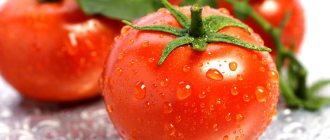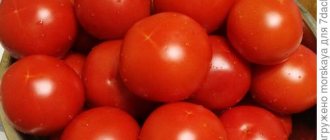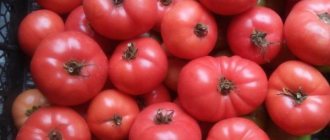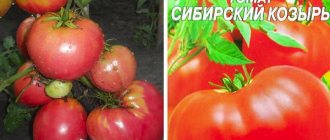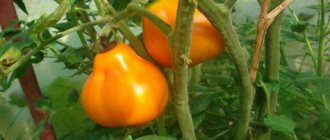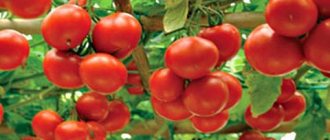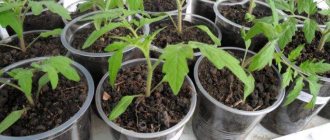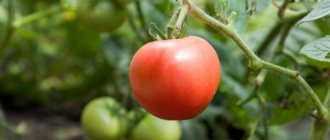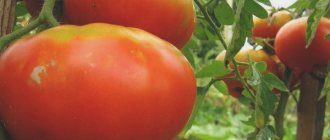» Vegetable growing » Tomatoes » Growing tomatoes Chelyabinsk meteorite
0
1120
Article rating
The relatively young tomato variety Chelyabinsk meteorite was bred by the famous breeder L. A. Myazina. It was included in the official register of vegetable crops in 2015. In a short period of time, the commercial and quality characteristics of the hybrid began to be studied by many vegetable growers in all regions of the country.
- Advantages and disadvantages
- Growing seedlings
- Seed preparation
- Soil preparation
- Technology and planting timing
- Seedling care
- Landing in the ground
- Care
- Watering
- Top dressing
- Bush formation
- Protection from diseases and pests
- Errors during cultivation
- Reviews from gardeners
Growing tomatoes Chelyabinsk meteorite
Brief information about the variety
- Fruits and bush : tomatoes weighing 50-90 g, round in shape, have a pleasant taste. The bushes are medium-sized (120-150 cm high), medium-leaved.
- Productivity : high, 3-4 kg of fruit can be harvested from one bush under favorable conditions;
- Resistance : the variety is resistant to diseases typical of tomatoes, most often affected by root rot and late blight. Requires preventive treatments.
- Distribution : capable of bearing fruit abundantly in all regions of the country. In the north, exclusively greenhouse growing methods are used.
- Application : the fruits are universal, suitable for fresh use and home canning.
- Planting : predominantly seedling method of cultivation, seed sowing time - March - April, seedling planting time - May - June, scheme: 3-4 bushes per 1 m².
- Care : the variety requires the formation of a bush of 2-3 stems, regular pinching and tying to a support. Needs fertilizing with organic and mineral fertilizers throughout the growing season. Watering is carried out as needed with warm, settled water.
- Ripening period : average, fruiting begins 4-4.5 months after sowing the seeds and occurs in July. The shelf life of the fruit is average.
Characteristics of the variety
The plant of the Chelyabinsk meteorite variety is a hybrid, so you cannot collect the seeds yourself for next year: the crop will lose its grade.
():
When re-sowing seeds of hybrids, in the second generation the plants may not have the characteristics of the mother plant.
Description of the bush
According to the description given by the seed manufacturer, the bush has the following characteristics:
- medium-sized - height reaches 120-150 cm, when cultivated in protected soil it grows up to 180 cm;
- the foliage is average, the shape of the leaf blades is interesting, which are similar to potato ones;
- bushes require gartering, pinching and shaping.
Description of fruits
Chelyabinsk meteorite tomatoes have the following characteristics:
- round fruits;
- the skin is smooth and elastic;
- the color of fruits in a state of biological maturity is deep red;
- the weight of one specimen ranges from 50 to 90 g;
- The taste of tomatoes is bright with barely noticeable sourness, the vegetables are juicy and aromatic.
Productivity and fruiting
The timing of fruiting depends on the region of cultivation, on average it occurs in July. When cultivated in a greenhouse, this period begins earlier. The formation of the ovary and ripening of the fruit takes a long time and ends before the onset of autumn frosts.
Yield indicators, according to the characteristics of tomatoes, are influenced by compliance with the basic rules for caring for the crop. Under suitable conditions, 12-13 kg of full-fledged fruits are collected from 1 m², so the variety is classified as high-yielding.
Application area
According to the description, Chelyabinsk meteorite tomatoes are distinguished by their versatility of use. They are used fresh, for preparing salads and snacks, and are also suitable for winter preservation.
The dense skin of the fruits, which prevents them from cracking under the influence of heat treatment, their small size allows them to be pickled and salted as a whole. The fruits are often used to make sauces, pastes, and juice.
Resistance to diseases and pests
Tomato Chelyabinsk meteorite F1 is resistant to the main diseases and pests that tomatoes are often exposed to. If you follow the rules of care and take preventive measures, the crop will be protected from these negative factors.
Growing regions
In the southern regions of the country, as well as in central Russia, the cultivation of the Chelyabinsk meteorite variety is practiced in open ground. In Siberia, the Urals (in particular in Chelyabinsk), in the Krasnoyarsk and Amur regions, where weather conditions are harsh, tomatoes are grown exclusively in greenhouses.
In the Urals, the variety is recommended to be grown in a greenhouse
With the right growing method, the variety is suitable for cultivation anywhere in the country.
Pre-winter sowing of tomatoes
Advantages:
- obtaining a large number of plants without a lot of time, effort and money;
- tomatoes are well hardened and can withstand low temperatures (4-7°C);
- tolerate sudden temperature fluctuations without visible problems;
- tomatoes are slightly affected by late blight even if there are foci of infection on the site:
- seedlings grow strong and healthy, do not stretch, and are resistant to sunburn;
- in long, warm summers their yield is higher.
Flaws:
- the sowing result is unpredictable, there may be no seedlings;
- the seeds germinate when the tomato seedlings are already planted in the ground;
- Only early and mid-early varieties can be grown;
- in most regions the method did not justify itself.
Winter planting of tomatoes in the ground is carried out in the fall in cold soil, when it has already frozen. In the middle zone this is the end of October, in the south it is mid-November. In the central regions, tomatoes are sown only in a greenhouse; in the south, if the soil does not freeze very much, they can be sown in open ground.
There are two ways of sowing: dry seeds and whole fruits.
Sowing with dry seeds
It is advisable to sow the seeds in a greenhouse, where they germinate 2-2.5 weeks earlier than in the ground.
When growing for seedlings, the soil does not need to be prepared, since in the spring the tomatoes are planted in a permanent place. Make a furrow and, without watering it, simply sow the seeds in a line. You can sow in nests at a distance of 15-20 cm from each other. Sprinkle the furrow with 2 cm of soil, insulate the top with fallen leaves or straw and leave until autumn. The soil must be cold and dry, otherwise the seeds will germinate and die. In the greenhouse itself it should not be higher than 5°C.
Whole-fruit planting
It is also done in a greenhouse, but on the Black Sea coast of the Krasnodar Territory, in the Crimea, in the Caucasus, it can also be planted in open ground.
They take a whole ripe fruit, make a hole in the ground 3-4 cm deep, place a tomato in it and cover it with 2-3 cm of soil. Cover the top with dry leaves and leave until spring. In spring a group of seedlings will appear here. The number of plants can be 5-30 pieces, depending on the number of sprouted seeds.
In the spring, as soon as the sun warms up, the leaves in the greenhouse are removed and the sowing area is covered with lutarsil. Outside, you will have to wait until the snow has completely melted and the first spring flowers appear, then the shelter is removed, and the tomato crops are also covered with film or lutarsil.
When the shoots appear, they put up arcs and make a temporary greenhouse. It is necessary even in a greenhouse, since at night there are still negative temperatures and the seedlings can freeze. There is no need to water them, since there is enough moisture in the soil at this time.
If tomatoes are grown as seedlings, then at the age of 3-4 true leaves they are planted in a permanent place in the ground, weather permitting. If planting is delayed, the tomatoes may not have time to produce a harvest.
When sowing tomatoes immediately in a permanent place after emergence, the winter crop is cared for as for seedling tomatoes.
Advantages and disadvantages
Among the many advantages of the young hybrid variety, the following are significant:
- the variety has increased stress resistance - it is able to form an ovary and bear fruit abundantly even under unfavorable conditions for it;
- the hybrid bears fruit consistently;
- the plant tolerates moisture deficiency and direct sunlight;
- The bushes of the crop are compact; when grown in a vertical position, they take up little space on the site, maintaining high yields.
Gardeners consider the main disadvantages of Chelyabinsk meteorite tomatoes to be the high cost of seed and the need to purchase it every new season.
():
The disadvantage of this variety is that it can be classified as a semi-determinate type (height 120-150 cm). This means that when grown in open ground, it definitely needs a high, strong support, but in a greenhouse it does not fully master its height and therefore irrationally uses the volume of the greenhouse space.
Growing seedlings
The hybrid Chelyabinsk meteorite under normal conditions is grown exclusively by seedlings. This allows you to properly prepare the plant for transplanting to a permanent place, which provides for earlier fruiting. In heated greenhouses it is possible to sow seeds directly onto the garden bed.
Seed preparation
The seed of a hybrid variety undergoes preliminary preparation for sowing, which is carried out by its manufacturer. The seeds are properly disinfected and fortified, so they do not require additional pre-sowing treatment.
For more active emergence of seedlings, seeds can be germinated by placing them in a cloth or napkin moistened with warm water for 1-2 days to allow the sprouts to swell and hatch. It is important to prevent the material from drying out during this period - the fabric bag with seeds should be regularly sprayed with a spray bottle.
Soil preparation
You can prepare the soil mixture for tomato seeds Chelyabinsk meteorite yourself by mixing fertile soil and humus in equal proportions, or you can purchase a ready-made substrate at specialized retail outlets. On the modern gardening market there are peat tablets that are designed for growing seedlings of various crops.
Before using a homemade soil mixture, it must be properly prepared using one of the suggested methods:
- heat in the oven or microwave at 200 ° (15-20 min.);
- pour with a solution of “Fitosporin” or potassium permanganate.
Technology and planting timing
The recommended time for sowing hybrid tomatoes Chelyabinsk meteorite for seedlings is March - April. It is important to pay attention to the climatic conditions of the region where the crop will be grown.
The sowing technology is as follows:
- pour a layer of prepared soil into boxes or individual containers and level it;
- seeds are sown in holes or furrows, 1-2 pieces each, leaving 2 cm between them;
- sprinkle the seed on top with a small layer of soil (1-1.5 cm) and carefully moisten it with a spray bottle, trying not to wash the seeds out of the soil mixture;
- the crops are covered with glass or film and placed in a dark, warm place;
- Condensate is periodically removed from the covering material.
Seedling care
Seedlings need sunlight
5-7 days after sowing the seeds, sprouts begin to appear on the surface of the soil. After this, you need to remove the film and transfer the seedlings to a sunny place. The necessary conditions for caring for seedlings are:
- stable temperature;
- sufficient lighting;
- ventilation of seedlings;
- proper watering as the soil dries using warm water.
After the appearance of 2 true leaves on the seedlings, if the seedlings are in common containers, it is necessary to transplant the sprouts into individual containers (picking). It should be carried out carefully, trying not to damage the delicate root system of the seedlings.
If the seedlings look weak, the stems are thin and weak, fertilize them with minerals. To prepare a nutrient solution, superphosphate (5 g), potassium sulfate (5 g) and ammonium nitrate (1 g) are mixed in 1 liter of water. This product moisturizes the soil under the seedlings.
():
During the initial period of growth, it is best to feed seedlings with special water-soluble forms of fertilizers specifically for seedlings: Aquarin, Mortar, Crystallon.
14-20 days before transplanting seedlings into a greenhouse, it is recommended to begin hardening them. To do this, the containers with them are taken out into the fresh air, gradually increasing the time they spend there. This procedure will allow young plants to quickly adapt to natural conditions.
():
If seedlings are planted in a greenhouse, they do not need any hardening. Greenhouse conditions differ little from room conditions.
Planting by month
When planning your harvest, it is recommended to purchase or create a tomato sowing calendar. If the housewife intends to grow tomatoes in a greenhouse, it is recommended to sow the seeds in January. The day before immersion in the soil, they need to be kept in warm water. It is worth finding out about the timing of sowing tomato seeds in different months. The most optimal numbers are days with a waxing moon. It is at this time that the plant juices move upward, so they are actively involved in transplanting and sowing.
January
In January 2021, they begin to plant tomato seeds for seedlings only if they are subsequently moved to a heated greenhouse. Favorable numbers in the winter month are:
- 1 number;
- 12,13,14;
- 20, 21;
- 24,25,26;
- 28,29.
The unsuitable days for sowing tomatoes in any month are the time of the new moon and the full moon. When the moon is full, plants should not be disturbed for 3 days.
February
Before sowing seedlings in the ground or greenhouse, they must be grown. Tomato sowing in February 2021 is carried out on the following dates:
- February 6 and 8;
- 11th, 12th, also 13th until 13:00 in the afternoon;
- February 15,16;
- 24,25,26 numbers.
March
In March, the trees wake up, the soil begins to warm up, and daylight hours increase. It is better to choose the following days for growing seedlings:
- 1 number;
- 17,18,19,20;
- 24,25,26,27,28 numbers.
Even residents of Siberia and the Urals can sow tomatoes in March 2020 for greenhouses. In this case, early ripening varieties are taken.
All experienced gardeners know that it is necessary to sow tomato seeds according to the lunar calendar. Now they sell different options, which indicate favorable din. In addition, it is necessary to acquire high-quality planting material. If you use bad seeds, the harvest will be weak, or the young plant will die completely before it has time to bear fruit. Then you need to take care of good soil. It is bought in stores or prepared at home. The soil should contain peat, humus, and turf mixture. They also carefully select the container for planting seeds. They use special boxes for seedlings and paper pots. Gardeners should remember that it takes 2 months for tomatoes to ripen. Based on this period, the time for planting the material on seedlings for subsequent planting in the soil or greenhouse is calculated.
Landing in the ground
Transplantation of seedlings into greenhouses is carried out at the end of April - May, into open ground - at the end of May - June, depending on the weather conditions of a particular region. At this point, the age of the seedlings is 45-55 days, they already have 6-8 leaves, and their height reaches 25-30 cm.
The area for tomatoes must be prepared and fertilized with humus in the fall. Before planting, carefully dig up the soil and mark the holes.
Planting scheme: 3-4 bushes are placed per 1 m², 30-40 cm are left between plants, 50-60 cm between rows. The depth of the hole should correspond to the size of the plant's root system. The checkerboard planting method is often used, which simplifies the care of the crop and the collection of fruits.
First, the soil under the seedlings is moistened, which will make it easier to remove it from the container. The seedlings, along with a lump of earth, are carefully placed in a hole, sprinkled with the required amount of soil, and lightly compacted. The seedlings are watered abundantly; to retain moisture for a longer period, the soil in the garden bed is mulched with peat, straw or sawdust.
Unfavorable days for sowing tomatoes for seedlings in 2020
Often those who deny the effect of the Moon on plants claim that even without the lunar calendar they managed to grow a rich harvest. In such cases, most likely, the seeds were planted on an auspicious day, and the person simply did not know about it.
In the past, my own sprouts often died, for no apparent reason. Then I didn’t know as much about the power of our Companion as I know now. I have been following this calendar for 5 years now and everything is fine.
Here I want to show you the unfavorable days in 2021 when you cannot sow seeds.
- January – 6 and 21.
- February – 5 and 19.
- March – 6 and 21.
- April – 5 and 19.
- May – 5 and 19.
- June – 3 and 17.
Care
By following all the rules for caring for Chelyabinsk meteorite tomatoes, even a novice vegetable grower has the opportunity to get a bountiful harvest. Agrotechnical techniques are not complicated, and sticking to them is not difficult.
Watering
You need to water tomatoes using settled warm water in the morning or evening, when there is no solar activity. The bed is moistened as needed, using the drip irrigation method or adding moisture strictly at the root. During the flowering period and at the beginning of fruiting, the amount of watering is reduced, and when the ovary is actively forming, it is increased.
Excess moisture creates a risk of fungal diseases, and the fruits begin to crack. The amount of water must be strictly controlled.
It is regularly recommended to loosen the beds and rid the soil of weeds. This is convenient to do after watering, when the soil is soft and pliable.
Top dressing
Plants need to be fertilized once every two weeks.
For tomatoes Chelyabinsk meteorite F1 use the following fertilizers:
- 1 week after planting the seedlings, it is watered with mullein solution at a rate of 1:15, which will stimulate the growth of green mass;
- during the formation of inflorescences, superphosphate and potassium salt are used (take 30-35 g of each substance per 10 liters of water);
- when the ovary is formed, mineral substances are used for irrigation, and boric acid is used for external treatment (2 g of product per 2 liters of water).
It is important to alternate mineral and organic fertilizers, applying them at intervals of 14-21 days.
Bush formation
It is recommended to form the Chelyabinsk meteorite tomato bush into 2-3 stems. All additional shoots and lower leaves are periodically removed by hand, leaving 8-9 clusters on the plant.
The variety requires garter to a support. It is necessary to fix not only the stems, but also the brushes, on which a large number of fruits will be located.
Protection from diseases and pests
The hybrid Chelyabinsk meteorite is classified as a variety with strong immunity, therefore, of all the diseases typical of tomatoes, only root rot (black leg) poses a real danger to it, and much less often late blight.
():
Rhizoctonia (“black leg”) affects only tomato seedlings at the seedling stage. Adult tomato plants are not affected by this disease.
To prevent their occurrence, it is necessary to regularly carry out preventive treatments with copper-based preparations or folk remedies, as well as organize proper care of the crop (ventilating the greenhouse, monitoring soil moisture).
Among the pests that pose a danger to the variety are mole crickets, aphids, spider mites, and whiteflies. They are used against them by spraying with chemicals (insecticides) or solutions and infusions based on tobacco leaves, wood ash, onions or garlic.
Diseases
Among the most common diseases that can destroy the entire crop:
Late blight. Occurs at high relative humidity and cool temperatures. The fungus multiplies intensively, affecting leaves and fruits. They become stained and the tomatoes begin to rot. You can spray the plantings with Bordeaux mixture. Or better yet, Fitosporin or Gamarin. Severely affected bushes are removed.
Manifestation of tomato late blight
- Black bacterial spot. Appears after prolonged rains and heat. Dark spots form on the leaves.
- Cladosporiosis. An olive-tinged coating appears on the leaves. The bush begins to fade. The reason is high humidity and high air temperature.
